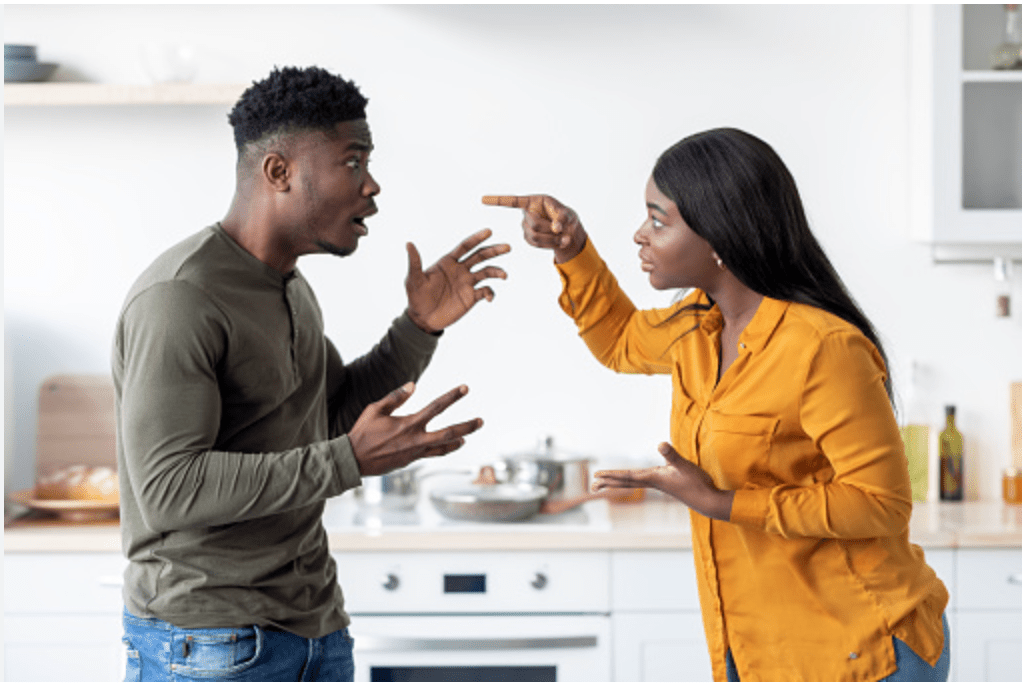HOW TO
How To Overcome Sexual Dissatisfaction In A Relationship
Published
7 months agoon
By
wpadminee
Do you go through sexual dissatisfaction? Or maybe you have, at one time, felt sexually unsatisfied? It’s a common experience for many couples. Various factors can contribute to this, including:
- Stress and fatigue: The demands of daily life can leave couples feeling exhausted and less inclined to engage in sexual activity.
- Communication issues: Difficulty in expressing needs and desires can lead to misunderstandings and dissatisfaction.
- Relationship problems: Underlying issues such as conflict, resentment, or lack of intimacy can affect sexual desire.
- Health concerns: Physical or mental health conditions can impact sexual function and enjoyment.
If you’re facing this challenge, don’t worry. It’s important to remember that many couples successfully overcome sexual dissatisfaction. Here are some steps you can take among numerous others:
- Open communication: Talk openly and honestly with your partner about your feelings and concerns.
- Seek professional help: A therapist can provide guidance and tools to address underlying issues.
- Prioritize self-care: Make time for relaxation, exercise, and healthy habits to reduce stress and improve overall well-being.
- Explore new experiences: Try new things in the bedroom to reignite excitement and passion.
Note that it’s completely normal to experience ups and downs in your sex life. With open communication, understanding, and a willingness to work together, you can overcome challenges and strengthen your relationship.
Join me as we go further on this topic of sexual dissatisfaction below.
What is sexual dissatisfaction?
Many couples face the challenge of sexual dissatisfaction. This can stem from various factors, such as:
- Relationship difficulties: Conflicts, resentment, or lack of intimacy can negatively impact sexual desire.
- Anxiety and stress: Emotional distress can reduce interest in sex and make it difficult to relax and enjoy physical intimacy.
- Lack of sexual activity: Infrequent or nonexistent sex can lead to boredom and dissatisfaction.
Sexual dissatisfaction means that you find sex unfulfilling or unpleasant with your current partner or in general. This is a significant issue because sex plays a vital role in most relationships.
Without a healthy and fulfilling sex life, couples may experience emotional distance, communication problems, and even relationship breakdown.
Is it normal to be sexually unsatisfied?
Sexual satisfaction is often considered a key component of a healthy and fulfilling relationship. It’s something that couples should strive to experience and enjoy together. However, for some, this is not always the case.
If you’re wondering whether it’s normal to feel sexually unsatisfied, the answer can depend on various factors. Consider these questions:
- Is the issue with you or your partner? Are there specific concerns or preferences that aren’t being met?
- Do you lack confidence or feel inadequate? Low self-esteem can affect sexual desire and enjoyment.
- Is a lack of intimacy contributing to the problem? Emotional connection and closeness are essential for sexual satisfaction.
- Are unrealistic expectations or miscommunication playing a role? Clear and open communication is crucial for understanding and addressing sexual needs.
If you’ve tried to address these issues on your own and are still struggling, seeking professional help can be beneficial. Also, understand that experiencing periods of sexual dissatisfaction is a common part of life. Many people go through these challenges at different points in their relationships.
What happens when you are sexually unsatisfied?
Sexual dissatisfaction is a common issue that affects many people. It can have a significant impact on various aspects of life, including:
- Low self-esteem: Feeling unfulfilled sexually can erode self-confidence and self-worth.
- Loneliness: Difficulty in connecting with others on a sexual level can lead to feelings of isolation.
- Relationship problems: Sexual dissatisfaction can strain relationships, leading to conflict, resentment, and even breakups.
- Sexual frustration: Unmet sexual needs can result in frustration, anxiety, and dissatisfaction.
While sexual dissatisfaction isn’t inherently a sex problem, it can certainly make sex less enjoyable. Some individuals may resort to unhealthy behaviours in an attempt to boost their self-esteem and improve their sexual satisfaction. These behaviours can include:
- Binge eating: Emotional eating can be a coping mechanism for dealing with dissatisfaction.
- Substance abuse: Using drugs or alcohol to numb feelings or escape problems.
- Risky sexual behaviours: Engaging in unsafe or impulsive sexual activities.
Over time, these unhealthy behaviours can take a toll on physical, mental, and social well-being. Potential consequences include:
- Depression: Emotional distress and low self-esteem can contribute to depression.
- Weight gain: Unhealthy eating habits can lead to weight gain and other health problems.
- Increased stress and anxiety: Chronic dissatisfaction and unhealthy coping mechanisms can exacerbate stress and anxiety.
It’s important to remember that there are many effective strategies to improve sexual satisfaction and overall well-being. Seeking professional help, practising self-care, and engaging in healthy communication with your partner are essential steps towards a more fulfilling life.”
How to Overcome Sexual Dissatisfaction in a Relationship
Not being sexually satisfied in a relationship can lead to its decline. So, how can you ensure sexual satisfaction in your relationship? Here are 5 ways to overcome sexual dissatisfaction and reignite the passion.
1. Talk to your partner about how you’re feeling.
Wondering how to tell your partner that you’re not sexually satisfied? Start by being open and honest about your feelings. Approach the conversation calmly and share your thoughts, allowing your partner to offer suggestions or ideas on how you can both improve your intimacy.
If you’re uncomfortable discussing this with your partner or feel unwanted sexually, confide in a trusted friend. They may be able to offer valuable insights and help you understand what might be going wrong. If you just need to vent, having someone listen could also relieve some of the stress you’re feeling.
2. Try some sex toys together.
Introducing sex toys into your relationship can be a great way to enhance your sex life. They add variety and excitement, helping you and your partner rediscover intimacy in new ways.
With so many options available, you’re bound to find something that suits your preferences. Explore different types together and see what works best before making a decision.
3. Schedule a date night with your partner.
Spending quality time together outside of daily routines can help rekindle the romance. Plan a date night or even a weekend getaway to reconnect and strengthen your bond.
Whether it’s a simple day at the movies or a romantic dinner, taking time to enjoy each other’s company can reignite the emotional and physical connection between you.
Experimenting with new positions, taking turns in pleasuring one another, or trying light bondage can also bring back the fun in your sexual relationship.
If you enjoy keeping things adventurous, consider adding a bit of BDSM play to your lovemaking. You may be pleasantly surprised by how it can reignite passion. If you’re looking for sex ideas, here are 8 kinky tricks to try.
5. Practice self-care.
Self-care is essential for maintaining a healthy relationship. Taking care of your physical and mental well-being allows you to better support your partner. Focus on eating well, getting enough sleep, and finding ways to relax at the end of each day.
Stress from a lack of fulfilment in your relationship can contribute to issues like erectile dysfunction, so it’s important to make a conscious effort to keep stress levels down as much as possible.
How to make your sex life better in your relationship
Do you often find yourself thinking, “I’m sexually unsatisfied in my relationship?”
A healthy sex life is crucial for keeping partners connected. Here are some common sexual issues in marriage and specific solutions to help improve your sex life:
Communication
Why is communication so important? It’s because the strength of a relationship largely depends on it.
The impact of communication on a relationship cannot be overstated. It helps partners feel loved, cared for, and understood, which is essential when it comes to making love. If one partner doesn’t feel valued or cherished, they won’t be eager to engage in a satisfying sexual connection.
A loving, healthy relationship naturally leads to a fulfilling sex life. On the other hand, when sex feels like an obligation rather than an act of love, it leads to sexual dissatisfaction. Over time, this can create feelings of resentment toward your partner.
Solution
If you struggle with communication but want to improve, start small. Spend time together doing simple things, like watching a movie and discussing it afterwards. Share details about your day or involve your spouse in light, everyday conversations.
As this becomes a habit, you’ll find it easier to talk about deeper issues. This open communication will make your partner feel valued and loved, resulting in more meaningful and affectionate intimacy rather than sex that feels obligatory.
Busy schedule
Balancing work, home responsibilities, and children can be exhausting, leaving little energy for intimacy. Stress and tension from daily life often have a direct impact on sex drive. When the demands of life weigh heavily, the first thing to suffer is usually the sexual connection between partners.
Sex isn’t just a mechanical act; it’s the meeting of desires and passions. But it’s hard to feel passion when stress and fatigue are constantly in the background.
After a long day of cooking, cleaning, caring for children, and maintaining the household, sex may feel more like another task than a source of relaxation.
Solution
Reduce the burden by organizing and prioritizing your tasks. Don’t feel pressured to accomplish everything in a single day. By prioritizing what’s truly important, you’ll realize that some tasks can wait until tomorrow.
Reducing your workload will help you relax and create more space for intimacy. While keeping a tidy home is important, nurturing your sex life should take priority as well.
No spark
For couples who have been married for a long time, the spark can sometimes fade, and sex begins to feel more like a routine chore.
When there’s no passion or excitement, sex can lose its appeal and become something you do just because it’s expected. This lack of spark is a common issue in long-term marriages and can lead to frustration.
You need that sense of excitement, where both partners feel fully satisfied and connected. When sex becomes mundane, it’s easy to put it off, leading to a cycle of “let’s do it tomorrow”—but tomorrow might never come.
Solution
All you need is a bit of effort to reignite that spark. Try something new—whether it’s dressing up, playing sensual music, or lighting scented candles to set the mood.
Scented candles can create a romantic atmosphere and add an element of surprise that will captivate your partner. This change can make your sexual encounters more passionate and sensual than before. The thrill of doing something different will heighten your desires.
Another great way to bring back the excitement is by experimenting with different positions. This requires both communication and participation from both partners, but it leads to a more engaging and enjoyable experience—often with some laughs along the way.
In the end…
Sex is not a task or chore to be checked off just because you’re married. It’s a beautiful experience that, when done right, leads to deep satisfaction.
If you’re in an unsatisfying relationship, don’t let sexual dissatisfaction cause your marriage to unravel. Take charge and reignite the magic.
If you enjoyed this article, read more here.
You may like
-


9 Things Men Do Only For The Woman They Respect
-


6 Things To Do If Your Partner Cheats And You Still Want Them
-


How To Stop Complaining In A Relationship
-


Why You Should Have Sex Often With Your Partner
-


11 Ways To Build Emotional Connection With Your Woman
-


5 Things You Must Do To Make Sex Easy In Your Relationship
HOW TO
How To De-Escalate Arguments In Relationships
Published
5 months agoon
November 24, 2024By
wpadminee
Arguments in relationships test every couple’s communication skills. They reveal deeper emotional dynamics. Healthy partnerships transform conflicts into opportunities for understanding.
Navigate arguments in relationships with strategic approaches. Stop escalation before it destroys the connection. Recognize that disagreements happen naturally. Your response determines relationship quality.
These relationship arguments require emotional intelligence. Listen actively. Control reactive responses. Use compassionate language. Avoid accusatory statements. Show genuine respect.
Understand that arguments in relationships aren’t battles to win. They’re conversations to understand. Each disagreement offers a chance to strengthen bonds. Develop mutual empathy.
The final key to managing arguments in relationships involves staying calm. Take deep breaths. Pause when emotions run high. Focus on solutions, not problems.
Successful couples treat arguments as growth opportunities. They communicate openly and respect each other’s perspectives. They commit to mutual understanding.
Choose connection over being right. Transform conflicts into moments of intimacy and trust.
Below are 6 tips you can use to de-escalate arguments in relationships:
1. Take a Break
Arguments in relationships can quickly spiral out of control. When conversations become heated, take a strategic timeout. Step away from the intense moment.
Give yourself space to reset emotionally. Take a walk to clear your mind. Listen to calming music. Practice meditation techniques. Breathe deeply and center yourself.
The goal of taking a break during arguments in relationships is emotional regulation. Return to the conversation when both partners feel calm and rational. This approach prevents saying hurtful things in the heat of the moment.
2. Active Listening
Mastering active listening transforms arguments in relationships. When your partner speaks, give full attention. Silence your inner defensive voice. Avoid interrupting or preparing counterarguments. Focus entirely on understanding their perspective.
Ask clarifying questions. Repeat what you’ve heard to ensure comprehension. Show genuine interest in your partner’s feelings. Demonstrate that you value their emotional experience.
3. Use “I” Statements
Language matters in arguments in relationships. Replace blame with personal vulnerability. Instead of accusatory statements like “You always ignore me,” express your feelings directly. Say, “I feel lonely and disconnected when we don’t communicate.”
“I” statements reduce defensiveness. They invite empathy and understanding. They transform potential conflicts into opportunities for a deeper connection.
4. Avoid Personal Attacks
Arguments in relationships should never become character assassinations. Stick strictly to the current issue. Avoid bringing up past mistakes or criticizing your partner’s personality. Focus on resolving the specific problem at hand.
Maintain respect. Treat your partner with kindness, even during disagreements. Your goal is collaborative problem-solving, not winning a battle.
5. Find Common Ground
Every argument contains potential for understanding. Look for areas of agreement, no matter how small. Acknowledge shared feelings or goals. Build a bridge of mutual understanding.
Collaborative approaches transform arguments in relationships from confrontations to conversations. Work together as a team. Seek solutions that satisfy both partners.
6. Seek Professional Help
Persistent communication challenges require professional intervention. A qualified therapist can provide:
- Objective communication strategies
- Tools for emotional regulation
- Insights into underlying relationship dynamics
- Personalized conflict resolution techniques
Professional guidance helps couples break destructive communication patterns. It provides skills for healthier, more understanding relationships.
Transforming Conflicts
Arguments in relationships are growth opportunities. They test and strengthen emotional bonds. By approaching conflicts with empathy, respect, and strategic communication, couples can turn challenges into moments of deeper connection.
Disagreements are normal. Respect is essential. Love is a continuous journey of understanding.
Click here to read more articles on relationships.
HEALTHY LIVING
How To Stop Snoring When Sleeping
Published
5 months agoon
November 23, 2024By
wpadminee
Snoring disrupts sleep for both the person snoring and their partner, lowering overall sleep quality. It’s more than a nighttime nuisance—it often signals health concerns like sleep apnea. Learning how to stop snoring is essential for better sleep and improved health.
To stop snoring, start by addressing your sleep position. Sleeping on your back can worsen snoring as gravity pulls the tongue and soft tissues backward, narrowing the airway.
Shift to your side to improve airflow. Another effective method for how to stop snoring is maintaining a healthy weight. Excess fat, especially around the neck, constricts breathing passages.
Lifestyle choices also matter. Avoid alcohol and sedatives before bedtime, as they relax throat muscles, making snoring worse.
Staying hydrated is another simple tip for how to stop snoring, as dryness thickens the mucus in the throat. For nasal congestion, saline sprays or humidifiers can keep airways open.
In severe cases, consult a doctor. Conditions like sleep apnea may require treatments such as CPAP machines or surgery.
Committing to these strategies can show you how to stop snoring effectively, transforming your sleep quality and overall well-being.
1. Lifestyle Modifications
- Weight Management: Excess weight, particularly around the neck, can contribute to snoring. Weight loss can alleviate this issue.
- Dietary Adjustments: Limiting alcohol and sedatives can relax the throat muscles, increasing the likelihood of snoring. A balanced diet can also help maintain overall health.
- Smoking Cessation: Smoking irritates the airways, making snoring worse. Quitting smoking can improve respiratory health and reduce snoring.
- Optimal Sleep Posture: Sleeping on your back can worsen snoring. Side sleeping or using a special pillow designed to keep you in a side position can be beneficial.
2. Over-the-Counter Remedies
- Nasal Strips: These adhesive strips can help open nasal passages, reducing snoring caused by nasal congestion.
- Oral Appliances: Mouthguards or dental devices can help keep the airway open during sleep. Consult a dentist for a proper fit.
3. Medical Interventions
If lifestyle changes and over-the-counter remedies are ineffective, consulting a healthcare provider is recommended. They may suggest:
- Continuous Positive Airway Pressure (CPAP): A machine that delivers pressurised air to keep the airway open during sleep.
- Surgery: In severe cases, surgical procedures may be necessary to correct structural issues in the throat or nose.
If you or your partner notices loud, frequent snoring, especially accompanied by symptoms like daytime sleepiness, choking sounds, or gasping for air, it’s crucial to seek medical advice. Prompt diagnosis and treatment can improve your overall health and quality of life.
By implementing these strategies and seeking professional help when needed, you can enjoy quieter nights and a healthier sleep pattern.
For more reads, visit here.
BEAUTY
How To Choose Jewelry For Your Personal Style
Published
5 months agoon
November 16, 2024By
wpadminee
Jewellery, a timeless accessory, can elevate your style and express your individuality. However, with countless options available, how to choose jewelry for your personal style can be overwhelming.
To choose jewelry for your personal style, start with understanding your personal style. Are you classic, bohemian, minimalist, or edgy? Once you know your style, you can start selecting pieces that reflect your personality.
How to choose jewelry for your personal style also involves considering your skin tone. Cool tones look best in silver and white gold, while warm tones complement gold and rose gold.
The type of metal you choose is another important factor. Gold is a classic and versatile option, while silver is modern and edgy. Rose gold is romantic and feminine, and platinum is luxurious and durable.
How to choose jewelry for your personal style requires considering the occasion, your face shape, and your outfit. Whether you’re looking for everyday pieces or statement jewelry, there’s a perfect piece out there for you.
By following these tips, you can confidently select jewelry that enhances your natural beauty and reflects your unique style.
Understanding Your Personal Style
Before diving into the world of jewelry, it’s essential to understand your personal style.
- Classic: If you prefer timeless elegance, opt for classic pieces like pearl necklaces, delicate gold chains, and simple stud earrings.
- Bohemian: Embrace your free-spirited side with layered necklaces, chunky bracelets, and earthy tones.
- Minimalist: Keep it simple with sleek, minimalist pieces like dainty rings and delicate pendants.
- Edgy: Experiment with bold, statement pieces like oversized earrings, chunky rings, and edgy necklaces.
Considering Your Skin Tone
Your skin tone plays a significant role in choosing jewelry that complements your complexion.
- Cool Tones: If you have cool undertones, silver, white gold, and platinum jewelry will enhance your natural beauty.
- Warm Tones: If you have warm undertones, gold and rose gold jewelry will complement your skin tone.
Selecting the Right Metals
The type of metal you choose can significantly impact your overall look.
- Gold: Gold is a classic and versatile metal that complements a wide range of styles.
- Silver: Silver is a modern and edgy metal that pairs well with contemporary outfits.
- Rose Gold: Rose gold is a romantic and feminine metal that adds a touch of warmth to your look.
- Platinum: Platinum is a durable and luxurious metal that is perfect for special occasions.
Choosing the Right Earrings
Earrings can instantly elevate your look. Consider the following factors when selecting earrings:
- Face Shape: Choose earrings that complement your face shape. For example, long earrings can elongate a round face, while stud earrings can accentuate a square face.
- Occasion: The occasion will determine the appropriate style of earrings. For a casual look, opt for simple studs or hoops. For a formal event, consider a chandelier or drop earrings.
Selecting the Right Necklaces
Necklaces can add a touch of elegance or a bold statement to your outfit. Consider the following factors when selecting necklaces:
- Neckline: Choose a necklace that complements your neckline. For example, a V-neckline looks great with a pendant necklace, while a high neckline pairs well with a choker.
- Outfit: The style of your outfit will determine the appropriate necklace. A casual outfit can be elevated with a simple pendant necklace, while a formal dress can be accessorized with a statement necklace.
Selecting the Right Bracelets
Bracelets can add a touch of sparkle to your wrist. Consider the following factors when selecting bracelets:
- Wrist Size: Choose a bracelet that fits comfortably on your wrist.
- Stacking: Experiment with stacking different bracelets to create a unique look.
- Occasion: The occasion will determine the appropriate style of bracelet. For a casual look, opt for a simple bangle or cuff bracelet. For a formal event, consider a delicate chain bracelet with gemstones.
Selecting the Right Rings
Rings can add a touch of glamour to your hands. Consider the following factors when selecting rings:
- Finger: Choose a ring that fits comfortably on your finger.
- Stacking: Experiment with stacking different rings to create a unique look.
- Occasion: The occasion will determine the appropriate style of ring. For a casual look, opt for a simple band ring. For a formal event, consider a cocktail ring or engagement ring.
You can choose jewelry that complements your personal style and enhances your natural beauty just by following the steps. Remember, the most important thing is to have fun and experiment with different styles to find what works best for you.
Visit here for more beauty tips.
Latest


Samsung Galaxy S25 Series Sets The Standard Of AI Phones As A True AI Companion
Samsung Galaxy S25 series sets the standard of AI phones as a true AI companion …Pioneering the multimodal era with...


5 Things To Expect In Afrobeats In 2025
Afrobeats is poised to reach unprecedented heights in 2025 as Nigerian music continues its remarkable global ascent. The genre’s explosive...


Here Are The 7 Most Ancient Countries On Earth
The oldest countries in the world stand as remarkable testaments to human civilisation, each containing landscapes and monuments that narrate...


Why Self-Reflection Is More Important Than Resolutions
Millions of people embark on a yearly ritual: they sit down with a notebook and pen, eager to craft a...


Nollywood Director, Kemi Adetiba Teases King Of Boys 3
Nollywood director Kemi Adetiba has revealed that another instalment of King of Boys will be released on December 25, 2025....


John McEnroe Says He Can Be The Commissioner Tennis Needs Amid Doping Crisis
Recent doping controversies involving top players have not damaged tennis’s reputation, but John McEnroe believes that appointing a single commissioner...


“Everybody Loves Jenifa” Becomes Nollywood’s Highest-Grossing Film Of All Time
Nollywood filmmaker Funke Akindele has achieved a historic milestone with her latest film, “Everybody Loves Jenifa.” The film has officially...


FG To Premiere TV Series, “Hidden Riches” On Mining Sector On January 25
Nigeria’s Federal Government will launch an ambitious television drama series focused on the nation’s mining sector, premiering “Hidden Riches” on...


Qing Madi Delivers A Soulful Performance Of “Favourite Pyscho”
Rising Afro-RnB sensation Qing Madi launches into 2025 with a mesmerising performance on the prestigious COLOURS platform, showcasing her latest...


Taiwo Awoniyi’s First Goal Of The Season Seals Nottingham Forest’s Win Over Wolves
Taiwo Awoniyi made a triumphant return to Premier League action. He scored in stoppage time to help Nottingham Forest crush...
-Ad-




